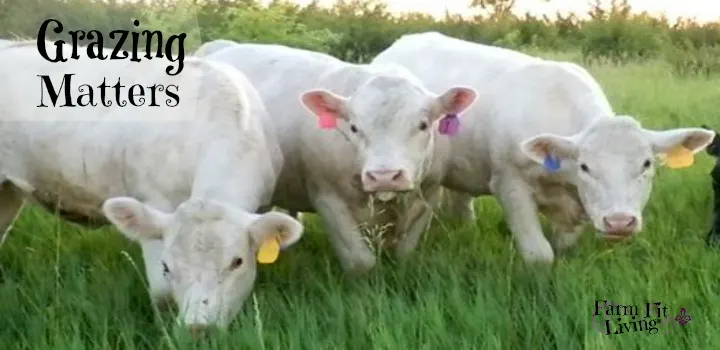Let’s talk grazing matters…because smart grazing matters.
Multi species grazing matters, that is.
Grazing different species of livestock together to control different types and kinds of vegetation is called multi species grazing. I’m talking about a three-way operation of cattle, goats and sheep. Let me explain further.
You know as well as I do that grazing livestock is where it’s at when it comes to animal husbandry feeding practices. When vegetation nutrition levels are at their peak, any livestock producer want their animals out there enjoying it.
Have you ever thought about what the different species like to eat best? Here’s the scoop:
Cattle prefer grass over other types of plants. They are much less selective when grazing than goats or sheep.
Sheep prefer forbs, such as broad-leaf weeds.
Goats really love to browse brush and shrubs before broad-leaved weeds.
Thus, grazing the three together on a diverse pasture should result in all types of plants being eaten. This is a win-win for your pasture.
So, what are the advantages?
1. Weeds and brush is controlled, reducing the amount of chemical used. This also promotes more grass re-growth.
2. Carrying capacity of the pasture as a whole is improved. You can add on more goats and sheep to every cow, resulting in profit in animals sold and returns gained. It is always best to not put all of your eggs in one basket! Diversification of livestock species results in diversification of income sources.
3. Multispecies grazing can also benefit pastures that are less diverse, but encouraging more even grazing. Cattle will tend to graze taller grasses other species reject, while sheep and goats graze near cattle manure deposits, which cattle avoid.
4. Predation losses are avoided with sheep and goats after a period of bonding. While this bonding period could last up to a few weeks, the three species tend to co-mingle eventually.
5. Parasite control is a major problem in sheep and goat herds but multispecies grazing sheep and goats with cattle is an easy parasite control system. Parasites are species specific, meaning cattle parasites affect cattle and not sheep and goats, while sheep and goat parasites affect them but not cattle.
Therefore, cattle can act as vacuum cleaners, ingesting the sheep and goat worm larvae and preventing them from affecting those species. The same goes for sheep and goats ingesting the cattle larvae. It’s a two-way street.
While there are numerous benefits, there are also a few problems to consider when co-grazing three species.
1. Bully animals may arise at any given time. Sometimes, it’s even the matter of the smaller animals with horns bullying the larger animals.
Our cattle chased the goats at first. It’s all a matter of adjusting them to each other and it may just take a little time to get their quirks worked out.
2. Supplemental feeding of trace minerals is an issue with the three-way co-grazers.
Cattle and goats can consume the same mineral, however, sheep cannot tolerate the copper levels. The main way to work around this is to continue to graze the animals on fresh pasture to get the nutrient benefits of the new pasture.
We also make sure the goats and cows get their copper levels from the minerals they must consume. This involves penning them separate from the sheep for 1 to 2 days per month. This is not a time consuming issue since we breed cattle and goats in their separate breeding pens during the summer months.
3. Fencing can be an issue when adding sheep and goats to cattle. Good luck keeping sheep and goats in a barbed wire or electric fence!
I prefer woven wire fencing. Here’s my post on keeping sheep and goats contained.
[Tweet “Have you considered grazing multiple livestock species to improve your operation?”]
Please comment below about your operation or with any question you may have!





Spring Pasture Management Tips for Grazing Cattle | Farm Fit Living
Friday 7th of April 2017
[…] Biologically: Multispecies grazing with sheep & goats. Read how I do it. […]